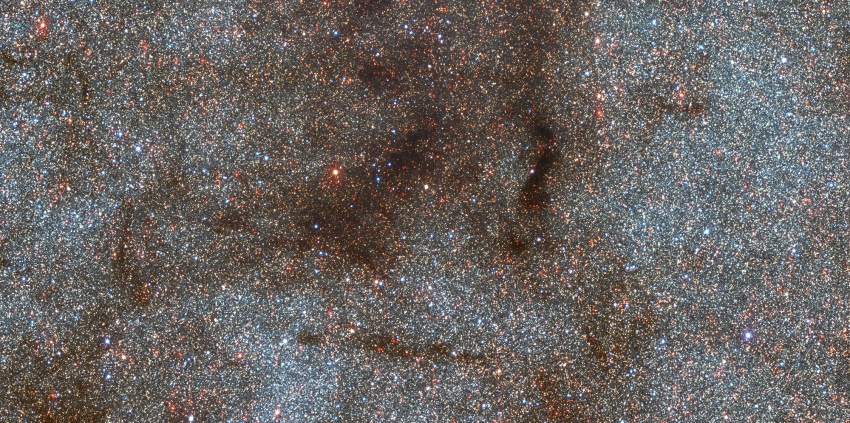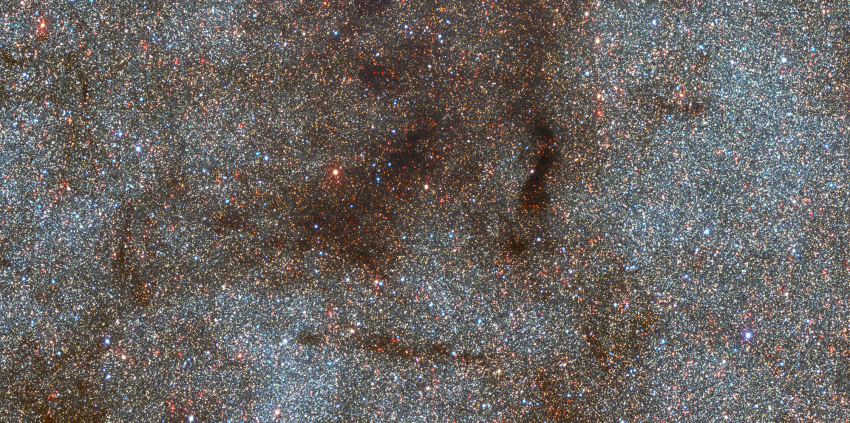New research has found that the majority of stars in our galaxy’s central bulge formed in a single burst of star formation more than 10 billion years ago. To reach this conclusion, astronomers surveyed millions of stars across 200 square degrees of sky—an area equivalent to 1,000 full Moons. The new work is published in two papers in Monthly Notices of the Royal Astronomical Society.
Our Milky Way galaxy is shaped like two fried eggs glued back-to-back: a central bulge of stars sits in the middle of a sprawling disc of stars. Though this is a common feature among spiral galaxies, astronomers have spent decades puzzling out how and when the Milky Way’s central bulge might have formed. Were the stars within the bulge born early in our galaxy’s history, 10 to 12 billion years ago? Or did the bulge build up over time through multiple episodes of star formation?
Now, a comprehensive new survey of millions of stars finds that most stars in the central 1,000 light-years of the Milky Way’s hub formed when it was swollen with infalling gas more than 10 billion years ago. This process may have been triggered by simple accretion of primordial material, or something more dramatic like merging with another young galaxy.
“Many other spiral galaxies look like the Milky Way and have similar bulges, so if we can understand how the Milky Way formed its bulge then we’ll have a good idea for how the other galaxies did too,” said co-principle investigator Christian Johnson of the Space Telescope Science Institute in Baltimore, USA.
“This survey gives us a big picture view of the bulge in a way that many previous surveys have not been able to do,” added co-author Caty Pilachowski of Indiana University, in the USA.
To reach their conclusions, the team studied the stars’ chemical compositions. They used the measured brightness of stars at different wavelengths of light, particularly in the ultraviolet, to determine their metal content.
Stars forming at different times would be expected to have different metallicities on average. Instead, they found that stars within 1,000 light-years of the galactic centre showed a distribution of metals clustered around a single average. This suggests that those stars formed in a brief firestorm of star birth.
The team surveyed a portion of the sky covering more than 200 square degrees – an area approximately equivalent to 1,000 full Moons. They used the Dark Energy Camera (DECam) on the Victor M. Blanco 4-meter Telescope at the Cerro Tololo Inter-American Observatory in Chile, a Program of NSF's NOIRLab. This wide-field camera is capable of capturing 3 square degrees of sky in a single exposure.
The team collected more than 450,000 individual photographs that allowed them to accurately determine chemical compositions for millions of stars. A subsample of 70,000 stars were analyzed for this study.
“Our survey is unique because we were able to scan a continuous section of the bulge at wavelengths of light from ultraviolet to visible to near-infrared. That allows us to get a clear understanding of what the various components of the bulge are and how they fit together,” said Johnson.
The wealth of data collected by this survey will fuel additional scientific inquiries, such as measuring stellar distances to make a more accurate 3D map of the bulge. The team also plans to look for correlations between their metallicity measurements and stellar orbits. That investigation could locate “flocks” of stars with similar orbits, which could be the remains of disrupted dwarf galaxies, or identify signs of accretion like stars orbiting opposite the galaxy’s rotation.
Is the Milky Way’s bulge-formation history unique or common in galaxy evolution? To answer that question, astronomers will have to look at galaxy assembly in the distant, young universe – a task for which NASA’s James Webb Space Telescope was specifically designed. “With Webb, we’ll have a front-row seat to watching galaxies like our Milky Way forming,” said co-principle investigator Michael Rich of the University of California, Los Angeles.
The Blanco DECam Bulge Survey is named in honor of Victor and Betty Blanco. Victor Blanco was the first Director of the Cerro-Tololo Inter-American Observatory; he and Betty Blanco also pioneered the study of the galactic bulge and Magellanic Clouds using the observatory’s 4-metre telescope.
Media contacts
Amanda Kocz
Press and Internal Communications Officer
NSF’s NOIRLab
Mob: +1 626 524 5884
amanda.kocz@noirlab.edu
Christine Pulliam
Space Telescope Science Institute (STScI)
Baltimore, Maryland
Tel: +1 410 338 4366
cpulliam@stsci.edu
Morgan Hollis
Royal Astronomical Society
Mob: +44 (0)7802 877 700
press@ras.ac.uk
Science contacts
Christian Johnson
Space Telescope Science Institute (STScI)
Baltimore, Maryland
chjohnson1@stsci.edu
Michael Rich
University of California, Los Angeles
rmr@astro.ucla.edu
Will Clarkson
University of Michigan
Ann Arbor, Michigan
wiclarks@umich.edu
Caty Pilachowski
Indiana University
Bloomington, Indiana
cpilacho@indiana.edu
Images, videos and captions
This video zooms into a view of the centre of our Milky Way galaxy, beginning with a photo that spans 71 degrees of the sky and ending on a new photo obtained by the Dark Energy Camera (DECam) at the Cerro-Tololo Inter-American Observatory in Chile. The new image covers 0.5 by 0.25 degrees (an area about twice as wide as the full Moon) and contains over 180,000 stars.
Credit: CTIO / NOIRLab / NSF / AURA, A. Pagan (STScI), W. Clarkson (UM-Dearborn), C. Johnson (STScI), and M. Rich (UCLA)
Further information
The new work appears in two papers:
"The Blanco DECam Bulge Survey. I. The Survey Description and Early Results", R.M. Rich, C.I. Johnson, M. Young, et al., Monthly Notices of the Royal Astronomical Society, 499 (2), pp. 2340–2356 (2020) (DOI: 10.1093/mnras/staa2426).
"Blanco DECam Bulge Survey (BDBS) II: Project Performance, Data Analysis, and Early Science Results", C.I. Johnson, R.M. Rich, M. Young, et al., Monthly Notices of the Royal Astronomical Society, 499 (2), pp. 2357–2379 (2020) (DOI: 10.1093/mnras/staa2393).
Notes for editors
The Royal Astronomical Society (RAS), founded in 1820, encourages and promotes the study of astronomy, solar-system science, geophysics and closely related branches of science. The RAS organises scientific meetings, publishes international research and review journals, recognises outstanding achievements by the award of medals and prizes, maintains an extensive library, supports education through grants and outreach activities and represents UK astronomy nationally and internationally. Its more than 4,400 members (Fellows), a third based overseas, include scientific researchers in universities, observatories and laboratories as well as historians of astronomy and others.
The RAS accepts papers for its journals based on the principle of peer review, in which fellow experts on the editorial boards accept the paper as worth considering. The Society issues press releases based on a similar principle, but the organisations and scientists concerned have overall responsibility for their content.
In 2020 the RAS is 200 years old. The Society is celebrating its bicentennial anniversary with a series of events around the UK, including public lectures, exhibitions, an organ recital, a pop-up planetarium, and the culmination of the RAS 200: Sky & Earth project.
Follow the RAS on Twitter, Facebook, Instagram and YouTube
Download the RAS Podcast from Audioboom
drupal-media[data-view-mode=half_page_width] { display: inline-block; width: 50%; }



